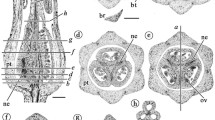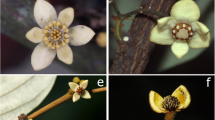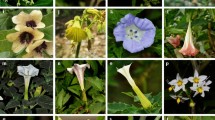Abstract
Tambourissa exhibits an unusual spectrum of floral diversity, tightly linked, however, by a common ground plan. Divergent evolutionary trends have led to small, closed flowers and to secondarily open flowers, including the largest of theMonimiaceae. The myophilous and cantharophilous flowers attract pollinators by scent, colour, stigmatic nectar and pollen. Some species have attained monoecy with partial or complete self-incompatibility, others even dioecy. Extraordinary evolutionary trends include the differentiation of a hyperstigma, the carpel group formation within a gynoecium, the increasing disorder in carpel orientation with increase of carpel number, and the formation of a pseudoperianth by the sterile lobes of the floral cup.
Similar content being viewed by others
References
Alberch, P., Gould, S. J., Oster, G. F., Wake, D. B., 1979: Size and shape in ontogeny and phylogeny. — Paleobiol.5, 296–317.
Baillon, H., 1869: Monimiacées. — In Histoire des plantes1, 289–344. — Paris: Hachette.
Bawa, K. S., 1980: Evolution of dioecy in flowering plants. — Ann. Rev. Ecol. Syst.11, 15–40.
Beach, J. H., 1981: Pollinator foraging and the evolution of dioecy. — Amer. Nat.118, 572–577.
Behnke, H.-D., 1981: Sieve-element characters. — Nord. J. Bot.1, 381–400.
Bock, W., 1979: The synthetic explanation of macroevolutionary change—a reductionistic approach. — Bull. Carnegie Mus. Nat. Hist.13, 20–69.
Carlquist, S., 1962: A theory of paedomorphosis in dicotyledonous woods. — Phytomorphol.12, 30–45.
Cavaco, A., 1959: Monimiacées. — InHumbert, H., (Ed.): Flore de Madagascar et des Comores (Plantes vasculaires)80. — Paris: Firmin-Didot.
Corner, E. J. H., 1976: The Seeds of Dicotyledons1, 2. — Cambridge: University Press.
Endress, P. K., 1972: Zur vergleichenden Entwicklungsmorphologie, Embryologie und Systematik beiLaurales. — Bot. Jahrb. Syst.92, 331–428.
—, 1979: Noncarpellary pollination and “hyperstigma” in an angiosperm (Tambourissa religiosa, Monimiaceae). — Experientia35, 45.
—, 1980a: Ontogeny, function and evolution of extreme floral construction inMonimiaceae. — Pl. Syst. Evol.134, 79–120.
—, 1980b: Floral structure and relationships ofHortonia (Monimiaceae). — Pl. Syst. Evol.133, 199–221.
—, 1980c: The reproductive structures and systematic position of theAustrobaileyaceae. — Bot. Jahrb. Syst.101, 393–433.
—, 1982: Syncarpy and alternative modes of escaping disadvantages of apocarpy in primitive angiosperms. — Taxon31, 48–52.
Givnish, T. J., 1982: Outcrossing versus ecological constraints in the evolution of dioecy. — Amer. Nat.119, 849–865.
Gottsberger, G., 1970: Beiträge zur Biologie von Annonaceen-Blüten. — Österr. Bot. Z.118, 237–279.
—, 1980: Reproductive biology in the primitive relic angiospermDrimys brasiliensis (Winteraceae). — Pl. Syst. Evol.135, 11–39.
Grant, V., 1950: The pollination ofCalycanthus occidentalis. — Amer. J. Bot.37, 294–297.
Greenwood, P. H., 1979: Macroevolution—myth or reality? — Biol. J. Linn. Soc. London12, 293–304.
Lorence, D. H., 1980: A systematic and eco-evolutionary study of theMonimiaceae in the Malgasy region. — Ph.D. Thesis, St. Louis: Washington University.
—, 1982: NewMonimiaceae from the Malagasy region (SW Indian Ocean). — Bull. Mus. Natn. Hist. Nat., Paris, Sér. 4,3, Sect. B, Adansonia, 293–304.
Mangenot, G., 1973: Données élémentaires sur l'angiospermie. — Ann. Univ. Abidjan, Sér. E,6, 1.
Perkins, J., 1925: Übersicht über die Gattungen derMonimiaceae sowie Zusammenstellung der Abbildungen und der Literatur über die Arten dieser Familie bis zum Jahre 1925. — Leipzig: Engelmann.
—, 1901:Monimiaceae. — InEngler, A., (Ed.): Das Pflanzenreich. IV. 101. — Leipzig: Engelmann.
Sampson, F. B., 1969: Studies on theMonimiaceae. 1. Floral morphology and gametophyte development ofHedycarya arborea J. R. etG. Forst. (subfamilyMonimioideae). — Austral. J. Bot.17, 403–424.
Solms-Laubach, H., 1885: Die Geschlechterdifferenzierung bei den Feigenbäumen. — Bot. Zeitung (Berlin)43, 561–572.
Sonnerat, P., 1782: Voyage aux Indes orientales et à la Chine. — Paris: Dentu.
Takhtajan, A., 1976: Neoteny and the origin of flowering plants. — InBeck, C. B., (Ed.): Origin and Early Evolution of Angiosperms, 207–219. — New York: Columbia University Press.
Thien, L. B., 1980: Patterns of pollination in the primitive angiosperms. — Biotropica12, 1–13.
Thorne, R. F., 1974: A phyletic classification of theAnnoniflorae. — Aliso8, 147–209.
Tulasne, L. R., 1855: MonographiaMonimiacearum. — Arch. Mus. Hist. Nat.4, 273–436.
Author information
Authors and Affiliations
Rights and permissions
About this article
Cite this article
Endress, P.K., Lorence, D.H. Diversity and evolutionary trends in the floral structure ofTambourissa (Monimiaceae). Pl Syst Evol 143, 53–81 (1983). https://doi.org/10.1007/BF00984112
Received:
Issue Date:
DOI: https://doi.org/10.1007/BF00984112




